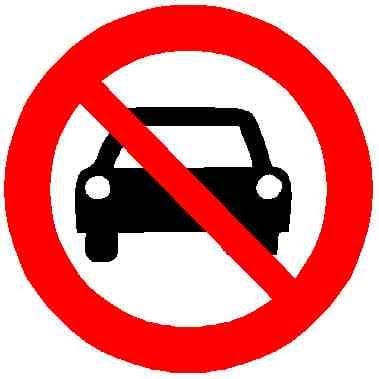


embedded machine learning research engineer - georgist - urbanist - environmentalist





The problem is tons of free parking everywhere needlessly sprawls out our cities, makes people drive further, and makes actual green methods of transit (like walking, cycling, and electrified public transit) less viable.
In the long term, maintaining car dependency is fundamentally incompatible with addressing the climate crisis. Removing mandatory parking minimums is a necessary step towards ending car dependency.


Exactly. I’m just trying to reframe dumb NIMBY policies like restrictive zoning and mandatory parking minimums as anti-freedom so as to try to get conservative NIMBYs to maybe be just a little less NIMBY.
Absolutely no one is seriously arguing we allow PFAS chemical plants next to kindergartens or that we remove all building safety codes. Just that restrictive zoning (and other NIMBY land use policies) is stupid, harmful, and we should get rid of it.


The right to a bicycle shall not be infringed


just a frame, a chain,
two wheels, and grease


Kinda tempts me to photoshop a RAM PRIDE or FORD PRIDE ad for pride month


Excellent point, brother. Always choose AMERICAN MUSCLE over COMMIE OIL.

Exactly. I’ve seen it with faaaaaar too many tankies and even populist leftists. Instead of advocating for empirically-driven policy that would measurably improve the world, there’s a ton of rhetoric about how we just need to punish capitalists/fascists/landlords/neolibs/billionaires/etc. harder to fix the world’s problems.
At this point, I think it’s just a deep-rooted flaw of the human psyche that we’re just inclined towards trying to force our solutions through by punishing those who oppose us, rather than trying to deeply understand the dynamics at play and changing the underlying structure to incentivize the outcomes we want.
And if we fail to address the tendency towards knee-jerk, brute-force, authoritarian “solutions” to problems within our own ranks, we’ll meet the same fate as every other revolution-turned-brutal-dictatorship.


The raison d’être for RISC-V is domain-specific architecture. Currently, computational demands are growing exponentially (especially with AI), but Moore’s Law is ending, which means we can no longer meet our computational demands by scaling single-core speed on general-purpose CPUs. Instead, we are needing to create custom architectures for handling particular computational loads to eke out more performance. Things like NPUs, TPUs, etc.
The trouble is designing and producing these domain-specific architectures is expensive af, especially given the closed-source nature of computer hardware at the moment. And all that time, effort, and money just to produce a niche chip used for a niche application? The economics don’t economic.
But with an open ISA like RISC-V, it’s both possible and legal to do things like create an open-source chip design and put it on GitHub. In fact, several of those exist already. This significantly lowers the costs of designing domain-specific architectures, as you can now just fork an existing chip and make some domain-specific modifications/additions. A great example of this is PERCIVAL: Open-Source Posit RISC-V Core with Quire Capability. You could clone their repo and spin up their custom RISC-V posit chip on an FPGA today if you wanted to.
It also had a second rule set where a land value tax was implemented, and the winning condition was when everyone made a minimum amount of money.
A land value tax (LVT) is a levy on the value of land without regard to buildings, personal property and other improvements upon it.[1] It is also known as a location value tax, a point valuation tax, a site valuation tax, split rate tax, or a site-value rating.
Some economists favor LVT, arguing it does not cause economic inefficiency, and helps reduce economic inequality.[2] A land value tax is a progressive tax, in that the tax burden falls on land owners, because land ownership is correlated with wealth and income.[3][4] The land value tax has been referred to as “the perfect tax” and the economic efficiency of a land value tax has been accepted since the eighteenth century.[1][5][6] Economists since Adam Smith and David Ricardo have advocated this tax because it does not hurt economic activity, and encourages development without subsidies.
LVT is associated with Henry George, whose ideology became known as Georgism. George argued that taxing the land value is the most logical source of public revenue because the supply of land is fixed and because public infrastructure improvements would be reflected in (and thus paid for by) increased land values.[7]
It’s just a stupidly good tax policy, and we should be implementing it in more places.


Yeah, this is the one piece a lot of people miss: in any decently competitive market, individual firms have effectively zero power to set prices; they must instead accept the prices determined by the market.
Knowing that, the solution to that sort of corporate BS, then, is to ensure markets are competitive by busting monopolies, lowering barriers to entry, and getting money out of politics to reduce the effect of lobbying.


That’s actually the neat thing about land value taxes; both in economic theory and observed practice, they can’t be passed on to tenants.
It would absolutely be a boon for the poor if we replaced other forms of taxation (such as on sales and income) with land value taxes. Plus, land value taxes tend to make housing cheaper, which helps the poor as well.

When Milwaukee implemented a housing-first homeless policy, they actually saved money.
Turns out that, by almost completely eliminating homelessness, you can save a lot of money on the legal system, policing, healthcare, and other costs associated with homelessness.
Housing-first homeless policy is the obvious solution: it’s humane, it’s effective, and it saves us money.


Exactly. People love to treat it as “a war on cars/lawns/etc.”, but it’s really a war on everybody who doesn’t want to be legally mandated to have those. All we’re asking for is to end the legal mandates (zoning, parking minimums, setback requirements, etc.) and for those who wish to partake in those wasteful luxuries to pay their true price without public subsidy.


Tbh, my favorite kind of gardening is the kind that thrives on neglect. I love making ecosystems that thrive on their own, without my constant input. There’s just something beautiful about seeing life thrive on its own.


It’s not, though. The classical factors of production, whence we get the concept of “capital” as a factor of production, has land and capital as clearly separate:
Land or natural resource — naturally occurring goods like water, air, soil, minerals, flora, fauna and climate that are used in the creation of products. The payment given to a landowner is rent, loyalties, commission and goodwill.
Labor — human effort used in production which also includes technical and marketing expertise. The payment for someone else’s labor and all income received from one’s own labor is wages. Labor can also be classified as the physical and mental contribution of an employee to the production of the good(s).
Capital stock — human-made goods which are used in the production of other goods. These include machinery, tools, and buildings. They are of two types, fixed and working. Fixed are one time investments like machines, tools and working consists of liquid cash or money in hand and raw material.
https://en.m.wikipedia.org/wiki/Factors_of_production
And it’s an important distinction. The fact that land is not made and inherently finite makes it zero-sum. Meanwhile, the fact that capital such as education, tools, factories, infrastructure, etc. are man-made and not inherently finite makes them not zero-sum. This distinction has truly massive implications when it comes to economics and policymaking. It’s the whole reason LVT is so effective, so efficient, and so fair: it exploits the unique zero-sum nature of land.


I got a positive one for you



You might like single transferrable vote (STV), then. You have districts with several seats in them (preferably ~5), and then do a ranked-choice ballot to select the candidates who will fill those seats. Key advantages over proportional representation are that it maintains the idea of a constituency and that it maintains voting for individual candidates, not just parties.
Downside, of course, is that it’s not as proportional as proportional representation, but it still achieves pretty proportional results. That’s the tradeoff for maintaining constituencies and individual candidates.


Property taxes != Land value taxes
Further, it’s not a tax on capital; it’s a tax on land. It’s very explicitly designed to target land, as land has distinct economic properties that make it a prime target for taxation.
And yes, it does target speculative investments like those of Blackrock:
It reveals that much of the anticipated future tax obligations appear to have been already capitalised into lower land prices. Additionally, the tax transition may have also deterred speculative buyers from the housing market, adding even further to the recent pattern of low and stable property prices in the Territory. Because of the price effect of the land tax, a typical new home buyer in the Territory will save between $1,000 and $2,200 per year on mortgage repayments.